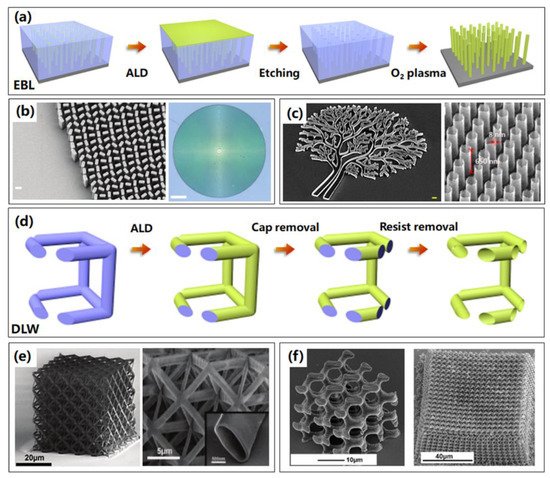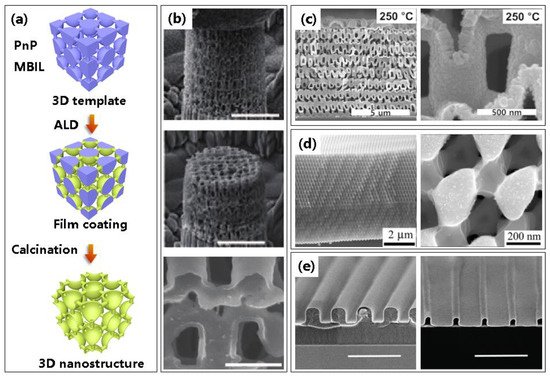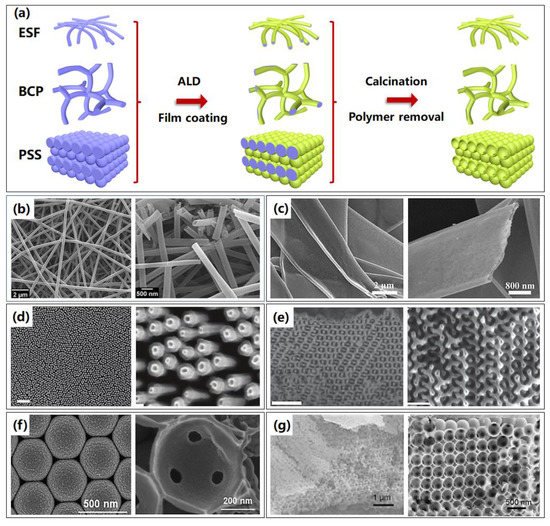1. Resist Polymer Templates
Due to the utilization of direct writing techniques, resist templates, including electron resists and photoresists, maybe the most flexible and controllable templates for 3D nanostructure fabrication based on ALA method. Nowadays, miniaturized conventional systems require the development of custom applications in imaging, displaying, and spectroscopy, especially for 3D nanosystems and 3D nanostructures. As a result, electron and photoresist templates, which could achieve 3D nanostructures by electron beam lithography (EBL) and direct laser writhing (DLW), are proposed and investigated in many fields, and their fabrication processes are illustrated in Figure 7a,d, respectively. Firstly, the electron or photoresists are patterned by EBL or DLW, and then ALD is applied to fill or coat the obtained templates to assemble 3D nanostructures which are confined by templates. Followed by the removal of the cap of the coated template and exposing residual resist polymer, the resist polymer is removed by O2 plasma or remover.
Figure 7. Resist polymer templates by EBL and DLW processes are used to fabricate various 3D nanostructures based on ALA method. (a) The illustrated process routine of 3D nanostructures based on electron resist templates through EBL technique. (b) SEM and optical images of the fabricated metalens. (c) SEM images of the tree-shaped irregular nanostructures and nanotubes with ultra-high aspect ratio of more than 80:1, based on ALA method through electron resist templates by EBL technique. (d) The illustrated process routine of 3D nanostructures based on photoresist templates by DLW technique using ALA method. (e) Overall and enlarged SEM images of the overall alumina octet-truss nanolattice through photoresist by DLW technique based on ALA method. (f) SEM images of two kinds gyroid photonic crystals through photoresist by DLW technique based on ALA method.
In 2016, a novel process for fabricating dielectric metasurfaces through soft electron resist templates based on ALA method was first proposed, which could produce anisotropic, subwavelength-spaced 3D nanostructures with shape birefringence [
53]. They patterned the electron resist using EBL firstly, resulting in templates with patterns in reverse of the final metasurface. Similar to the process to fabricate 3D nanostructures as discussed above, ALD-based TiO
2 films were coated on the template, followed by the removal of TiO
2 cap and residual resist, high performance 3D nanofin metasurface as a metalens, as shown in
Figure 7b, was successfully fabricated and showed widespread applications in laser-based microscopy, imaging, and spectroscopy. This ALA process should be the simplest strategy to realize the complex 3D nanostructures of dielectric metamaterials up to now, which is also capable of achieving any high-efficiency metasurface optical element. Geng et al. developed the ALA method deeper to fabricate 3D nanostructures utilizing electron beam resist, resulting in large-scale arrays of multiple complex 3D nanostructures with high resolution down to nanometers and ultra-high aspect ratio of hundreds. Particularly, an extreme structural nanotube array with ultra-high aspect ratio of more than 80:1 (8 nm wall thickness and 650 nm height) is assembled successfully. The results are displayed in
Figure 7c [
54].
Creating lightweight, mechanically robust materials has long been an engineering pursuit. Many siliceous skeleton species, such as diatoms, sea sponges, and radiolarians, have remarkably high strengths compared with man-made materials of the same composition, yet are able to remain lightweight and porous [
55,
56]. As shown in
Figure 7e [
57], to investigate the lightweight nanostructures, creation of ceramic nanolattices begins with the design and writing of a negative photoresist template using two-photon lithography direct laser writing (DLW), achieving a polymer sacrificial template. Al
2O
3 film is then deposited onto the soft template by ALD, so that it coats the entire surface of this 3D skeleton. Then the internal polymer is etched away in O
2 plasma after the removal of the outermost sides of the coated structure by focused ion beam milling (FIB), resulting in 3D ceramic nanolattice consisting of a network of hollow tubes, which can recover their original shape after compressions in excess of 50% strain. This fabrication method enabled the creation of 3D structures with numerous geometries and custom designs, exhibiting a strong, ultralight, energy-absorbing, and recoverable metamaterial, called a mechanical metamaterial. Using a similar technique based on a photoresist template, gyroid photonic crystals were fabricated successfully, as shown in
Figure 7f, which exhibited a complete bandgap in infrared spectroscopy measurements [
58].
Due to the fact that it commonly relied on negative resists using two-photon lithography, the 3D nanostructure fabrications based on photoresist are limited [
59,
60], whose topography and size are restricted. Consequentially, electron resist shows more advantages than DLW photoresist in fabricating 3D nanostructures based on ALA method, which can maximize the virtues of following ALD process in flexible custom topography, precise size control, and more compatibility, further showing giant applications in various optical devices [
61,
62,
63,
64,
65,
66,
67,
68]. Despite the long-time consumption, the fabrication of 3D structures through resist polymers by ALA method shows incomparable flexibilities and great compatibility with conventional semiconductor processes, showing ability in achieving arbitrary custom pattern and complicated 3D structures with extreme geometries. New techniques combined with ALA method, like nanoprinting and multibeam exposing, should be developed to reduce the time consumption.
Apart from EBL and DLW, several other techniques could be utilized to pattern resist templates. As presented in Figure 8a, two feasible techniques to pattern photoresist templates are the proximity field nanopatterning (PnP) technique and multibeam interference lithography (MBIL).
Figure 8. Other photoresist polymer templates by PnP and MBIL processes are used to fabricate 3D nanostructures by ALA methods. (a) Illustrated process routine of 3D nanostructures based on photoresist templates by PnP and MBIL techniques. The two techniques commonly share the same fabrication process, except the methods to fabricate resist templates. (b) SEM images of Al2O3 nano-architectures based on PnP technique taken before and after compression tests. And the enlarged SEM images of Al2O3 nano-architectures. (c) SEM images of 3D ZnO hollow nanostructure deposited at 250 °C after removal of the epoxy template based on PnP method. (d) 3D TiO2 photonic crystals after removal of the polymeric template by MBIL method. (e) SEM images of polymer grating template by MBIL method with Platinum film by ALD; and free-standing Pt nano-accordions after removal of the template.
PnP is a versatile 3D nanopatterning technique that creates highly ordered 3D nanostructures in photosensitive materials by capturing the 3D light distribution, generated by a phase mask with periodic relief structures. The 3D light intensity distribution, called the Talbot effect or self-imaging effect [
69,
70], has periodically repeated images generated by interferences of diffracted beams. This method can rapidly fabricate 3D nanostructures through only single exposure over a large area (>1 inch
2) [
71]. As displayed in
Figure 8b, hollow-tube-based 3D Al
2O
3 nanoarchitectures functionalized as lightweight materials were fabricated in large areas using PnP and ALA process [
72]. The first two SEM images show nanoarchitectures taken during compression and after complete unloading, which revealed that the strengths of these nanoarchitecture materials were powerful. The zoomed-in image of the single unit cell is exhibited in the bottom of
Figure 8b. Another group [
73] reported a truss-like 3D hollow ZnO nanostructure using PnP method that exhibits a drastically improved elastic strain limit while maintaining a piezoelectric coefficient similar to that of single crystal ZnO, showing excellent potential application in enhanced haptic devices, flexible sensors, and energy harvesters. The SEM images of 3D ZnO hollow nanostructures after removal of the epoxy template are displayed in
Figure 8c.
Unlike PnP method, multibeam interference lithography (MBIL) is a maskless and practical fabrication technique of periodic microstructures over large areas [
76,
77]. This technique possesses advantages of low cost, no contamination, and fabricating pattern over a large area (up to mm in diameter), but the variety of the patterns is limited due to the exposure mechanism of MBIL, such as an anisotropic and aperiodic structure cannot be achieved by this method. By recording four-beam interference pattern into photoresist, a periodical pillar array is obtained as the sacrificial template [
78], which can be used to form microlenses [
79,
80], optical biosensors [
81], or microaxicons for beam generation [
82]. The production and optical characterization of a high-quality, high-index 3D photonic crystal using MBIL and ALD was first demonstrated in 2006 [
74]. A high-quality photonic crystal in amorphous TiO
2 was produced after removal of the polymer template, showing potential applications in all-optical circuits, microcavity-based light emitters, and other microstructured photonic devices, as shown in
Figure 8d. Min et al. [
75] also prepared complex Pt nano-accordion structures using a combination of MBIL and ALA; these metal nanostructures have good structural stability and electrical conductivity, as shown in
Figure 8e, and their cross sectional profiles can be designed by specifying the template geometry, showing applications in stretchable electronics, photonics, and nanofluidics.
PnP and MBIL methods consume less time than EBL and DLW techniques, which reduces the fabrication cost greatly. Remarkably, there is also no anisotropic volume shrinkage occurring during the calcination to remove the template in the fabrication by PnP and MBIL, providing beneficial optical properties and mechanical stability, showing potential applications for highly efficient gas sensors by utilizing high porosity and large surface area. However, the simplex and inflexible morphologies by PnP and MBIL show less flexibility and controllability, which may limit the application area.
2. Assembled Polymer Templates
As well as resist polymers, alternative soft templates can be the variously assembled polymer templates, which generally include a wide variety of high polymers of electrospinning fibers (ESF), blocked polymer (BCP), and self-assembly polystyrene spheres (PSS), and so forth. Obviously, ESF were fabricated by electrospinning technique, and self-assembly technique is applied to obtain the BCP and PSS templates. The 3D nanostructure fabrication processes based on ALA method through ESF, BCP, and PSS templates are similar, which firstly are the preparation of templates by corresponding techniques, followed by film deposition by ALD, and removal of templates by calcination, as shown in Figure 9a.
Figure 9. Typical assembled polymer templates are combined with ALA method to fabricate 3D nanostructures. (a) The illustrated process routines of 3D nanostructures based on assembled polymer templates through electrospinning fibers (ESF), blocked polymer (BCP), and polystyrene spheres (PSS) templates. (b) Representative SEM images of AlN hollow nanofibers based on electrospinning after calcination. (c) Overall and cross section SEM images of belt-like BiVO4@ZnO heterojunction based on electrospinning after calcination. (d) Overall and enlarged SEM images of the nanorockets array based on BCP technique. (e) SEM images of two kinds of mesoporous ZnO networks based on BCP technique. (f) Overall and cross section SEM images of TiO2 inverse opals based on self-assembled PS spheres. (g) SEM images of based TiO2 inverse opals on self-assembled PS spheres.
The major advantages of the electrospinning process are easy operating and cost-effective to implement. The wide band gap semiconductors based on electrospinning through the ALA method, such as ZnO [
88,
89], SnO
2 [
90,
91], and TiO
2 [
88,
92], including CuO [
93], depicted unique surface functionalities and higher sensitivities toward ethanol, O
2 [
89,
94], NO
2 [
91,
92], CO [
92,
94], NH
3 [
88,
90], H
2 [
90,
95], and so forth. As a result, the 3D nanostructures based on electrospinning toward sensors were widely investigated. Haider et al. [
83] reported fabrication and characterization of aluminum nitride (AlN)/boron nitride (BN) bishell hollow nanofibers through successive ALD of AlN and sequential chemical vapor deposition (CVD) of BN on electrospinning polymeric nanofibrous sacrificial templates, which are exhibited in
Figure 9b. This specific structure might find potential use in composite reinforcement, chemical sensing, and gas adsorption. In addition to sensors, nanofibers based on electrospinning and ALA also displayed enhanced photocatalytic activity in water splitting [
96,
97]. The fabrication of BiVO
4@ZnO heterojunction with a novel nanostructure for water splitting via electrospinning and ALA techniques were investigated [
84], as shown in
Figure 9c. The belt-like 3D structure exhibited enhanced photoelectrochemical performance and showed potential applications in solar cells. There are plenty of low-cost polymer materials to form polymer fiber templates using electrospinning; they could be polyacrylonitrile (PNA) [
95,
98], Nylon [
99,
100], polyvinyl acetate (PVA) [
92,
93], or Poly (vinylpyrrolidone) (PVP) [
84,
101], which show great opportunities in commercial applications.
Another important assembled polymer template for fabricating 3D nanostructures is the blocked polymer (BCP). The blocked copolymer template-assisted method, which is based on a self-assembly process, can generate well-ordered arrays with small feature sizes of 5–50 nm in dot, line, hole, or lamellar patterns, and has been extensively explored as a strategy to form periodic nanostructures [
102,
103]. BCP combined with ALA for wafer-scale to fabricate ultrasmall coaxial TiO
2/Pt nanotubes was reported, which is used as a catalytic rocket with a length below 150 nm and a tubular reactor size of only 20 nm, leading to the smallest man-made rocket engine reported to date, as shown in
Figure 9d [
6], demonstrating abilities to efficiently power the directional transport of significantly larger passive cargo. Two other different morphologies based on the self-assembly of BCP were synthesized to fabricate mesoporous ZnO networks, as shown in
Figure 9e [
85]. The manufacture of ZnO-based solar cells also showed the feasibility of the integration of the 3D mesostructured ZnO networks into photovoltaic devices.
3D nanostructure could also be formed by the inverse opal (IO) structures, which possess size adjustable pore structure, large surface area, and optical properties of photonic crystals. The inverse opal nanostructures are usually fabricated using a template of silica [
50] or polymer micro-spheres by the self-assembly route. Polystyrene sphere (PSS) templates are most commonly used and easily removed by calcination. Inverse opal TiO
2 nanostructures [
86] were synthesized by ALA using a template with ordered layers of PS spheres deposited on a Si substrate by spin coating, as illustrated in
Figure 9f, where the IO nanostructures showed giant photocatalytic enhancement for the degradation of methylene blue than that of planar TiO
2 films. Similarly, a TiO
2/MoS
2 core/shell inverse opal structure was fabricated based on ALA on a self-assembled multilayer PSS template, as presented in
Figure 9g. As a 3D photonic crystal, the TiO
2/MoS
2 inverse opal structure exhibited obvious stopband reflecting peaks, which can be adjusted through changing the opal diameters as well as the thickness of the MoS
2 layer [
87]. The inverse opal structures could find plenty more applications in photocatalytic [
104,
105], solar cells [
106,
107], chemical sensors [
108,
109], surface enhanced Raman scattering (SERS) detection [
110,
111], etc.
The advantage of the ESF, BCP, and PSS template assisted methods should be that no complex and expensive equipment are applied to prepare the templates, as well as easy modification and feasibility of industrial-level high-volume mass production.
This entry is adapted from the peer-reviewed paper 10.3390/mi13060856



